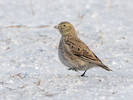search
classification
|
basic information
|
video
|
reports |
Black Lark
Melanocorypha yeltoniensis (J.R.Forster, 1768)

|
 male
|
|
|
2013-02-24
Barnaul, Altai territory |
© Ivan Belyaev
|
|
Description
Black Lark is large, Starling-sized bird. Male on breeding plumage is all black often with whitish tips of feathers on upperparts, head and rare on breast. Female is whitish-brown often buffy tinged. Female color is very variable both individual and seasonally. Mostly females have typical lark coloring but the streaks are not neat and generally color is plainer. Underparts are whitish with not neat streaks which can merge and form the large brownish patches on craw-sides. Other females are motlier or darker. In autumn, after the summer molting all plumage is with broad whitish or buffy edges on feathers. On males upperparts this edges form the solid buffy-whitish color; underparts are with narrower edges and look mottled but mostly black. During the winter the pale edges worn and males become more and more black. Female upperparts feathers have brownish shafts and broad whitish borders; females' seasonal colors also are governed by the full summer molting and the winter wearing of feathers. But seasonal differences on female aren't as appreciable as ones on males. However the autumn and winter females look very pale and inconspicuous on a snow especially on dusty one. But in the middle summer the females are usually very dark, almost brownish and almost plain. Male have black legs and yellowish on autumn, bluish on spring bill. Female legs are brown or buffy-brown, female bill is greyish-horn. Juveniles on first plumage are brownish pale mottled. After the summer molting juveniles are similar on adults. On all plumages underwings are dark, black on males, brown on females. Male weight 55-76, female weight - 51-68 grams, long 18-22, male wing 12,4-14,4, female wing - 11,1-12,7, wingspan 37-43 cm.
Distribution
The Black Lark breeds in the northern half of Kazakhstan (except the Kokchetav highlands), in south to Volga-Ural sands (Iglik, Ishingali, Koktau), lower Emba river, western edge of Bolshiye Barsuki, north coast of Aral Sea, Northern Trans-Balkhash area and Zaysan depression. It is not rare in Pavlodarskoye Trans-Irtysh'e. At 20 May 2002 two males observed close to Kulsary. On passage and on wintering occurs in south; sometimes observed on Barsa-Kelmes island, at Chimkent, in Western Tien Shan foothills and in Almaty area.
Biology
The Black Lark is common resident. Inhabits steppe (wormwood, feather-grass, fescue/grass) often with scattered bushes, and semi-desert (near saline soil on meadow patches with Lasiagrostis, feather-grass and wormwood). It is important the presence of grassless or rare-grass ground. Therefore it often nests near the ground tracks and sheep paths. During passage and in winter concentrates on pastures, stubble fields, near roads and settlements. Arrival at breeding sites occurs in late February to March when the snow-free areas appear. Couples form in April. Probable some pairs are formed still in the spring flocks. Pairs breed 80-700 m one from other. Nest is built in shallow scrape under grass shelter and is made from dry grass lined with soft grass and scraps of vegetation. Clutches of 3 to 7 eggs in early April – late June. Only female incubates. Both parents feed juveniles, which fledge at 9-11 days old, in mid May – early July. Repeated breeding after loss of first nest is common. It feed juveniles by insects; in summer adults also mostly eat insects but also eats the seeds. Probably it cannot shift without water because it flies to watering places even in breeding season. Males predominate in broods and comprise 68% of juveniles. Flocks of non-breeding males were observed from May to June on the shores of Tengiz lake, where they do not breed. Juveniles gather independently in flocks in June, and from this time till the next spring Black larks lives in flocks. In winter, males wander in huge flocks of up to several hundred birds. Such flocks regularly comprise only 10-20% females recorded among them. Flocks of females numbering up to several dozen birds rarely recorded. Wanders both inside and outside of breeding range, also in north until the forest-steppe zone. Females prefer to wander in south but males - in north. In spring the mixed flocks occurs but mostly the flocks of females still wander when the males already settled live on breeding areas. In inter-season period the vegetative food prevails, and in the winter the seeds of grasses are almost exclusive forage. Birds pick up the seeds from plants sticking out over the snow, and also from the ground. Thus Larks can dig out the thin snow by feet as Hens, but in the deep snow dig the holes depth till 10-15. It can break an ice crust by the strong bill. Most of all it prefers to feed on the roads.
References
Gavrilov E. I., Gavrilov A. E. "The Birds of Kazakhstan". Almaty, 2005.
В.К.Рябицев. "Птицы Урала, Приуралья и Западной Сибири". Екатеринбург, Изд-во Уральского университета, 2000.
Э.И.Гаврилов. "Фауна и распространение птиц Казахстана". Алматы, 1999.






